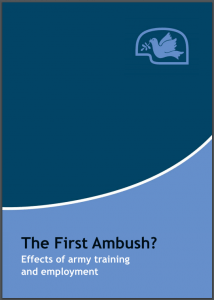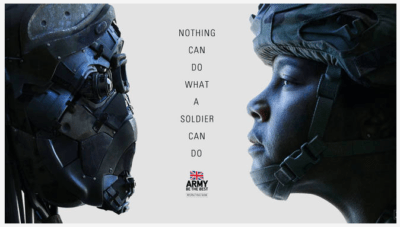Stripping the Civilian – how army training isolates, disorientates and dominates recruits
ForcesWatch comment

Many British army recruits are young and vulnerable. 22 out of every 100 UK army recruits are under eighteen – children, by international standards. At enlistment, British recruits are more likely to be 16 than any other age.
While multiple reports and studies demonstrate the dangerous long-term impacts of early enlistment and relate this to combat itself, little research has been done on the impacts of military training.
A new report from Veterans for Peace UK, released today (4 July 2017), tackles the nature and effect of military training using veterans’ testimonies and around 200 studies (mainly from the UK and USA).
The First Ambush? Effects of army training and employment is an in-depth exploration of the nature of training and what it does to recruits.
In short, the purpose of that training, from the initial stages onwards, is to mould young civilians as soldiers; to follow orders by reflex and to kill on demand.
Risk of violent offending and heavy drinking rises after joining the army, according to our report released today. pic.twitter.com/huUD6CK9hz
— VFP UK (@vfpuk) July 4, 2017
That, the report explains, demands unquestioning obedience, aggression, antagonism. Normal inhibition to killing must be overpowered through a dehumanising training regime. The lasting effects of this training are many and set out thematically across the 72-page report in terms such as ‘forced change’ and ‘moulding the soldier’.
At any time – and for any reason – training instructors can deprive recruits of sleep, food, shelter or permission to go the lavatory. Harsh treatment known as beastings are commonplace. These involve insults and shouting as well as physical violence aimed at recruits in order to humiliate.
One section – entitled ‘Stripping the Civilian’ – focuses on the basic components of army training. This aims to suppress and overpower recruits’ civilian identities; in effect stripping these away.
This begins with isolation – for the first few weeks trainees, heads shaved and in uniform, have no right to see family or friends; they are not allowed to leave base and cannot terminate their contract. That is the case even when the recruit is under 18 years of age.
The military also dominates recruits by denying them any choice of personal affairs; their daily routine is controlled totally down to tiny details such as the right and wrong way to stand, make a bed or fold clothes.
At any time – and for any reason – training instructors can deprive recruits of sleep, food, shelter or permission to go the lavatory. Harsh treatment known as beastings are commonplace. These involve insults and shouting as well as physical violence aimed at recruits in order to humiliate.
Instructors will punish a struggling recruit who is, as British Infantry veteran James Florey has characterised it, ‘singled out for weakness, humiliated, and isolated.’ The purpose is to instil fear in the group and the individual so as to bring about compliance. It builds the unitary nature of the group because often the whole group is punished for ‘the individual’s apparent failure’.
The First Ambush shows that military training and culture can be harmful, with health implications even before a soldier reaches the frontlines – such as substance abuse, mental illness, domestic abuse and sexual harassment.
The youngest and most disadvantaged recruits are the most vulnerable to these issues. Further, the Army likes to present itself as a social mobility boost for young people, but in fact the youngest and most disadvantaged are also the most likely to drop out of the army early and be at risk of unemployment and deprivation. We discuss this further here.
The First Ambush also demonstrates that the risk of violent offending and heavy drinking rises after joining the army. A study in 2013 found that enlistees were less likely to commit crime in general after enlistment, but more likely to commit violent and sexual offences. After deployment, the risk is doubled relative to the pre-enlistment offending rate.
The Ministry of Justice states that veterans represent between 4% and 5% of the UK prison population. Over 2,500 veterans entered the prison system last year, with experts warning that ‘a disproportionate number were being jailed for serious violence and sexual offences.’
These offences can be connected with service-related alcohol abuse and PTSD, to which those recruited as children and who have experiences of childhood adversity are most prone.
These findings on military training further substantiate our call, which 78% of the general public agree with, for the minimum recruitment age to be raised to eighteen.
They also add weight to our concerns that military youth engagement often targets disadvantaged young people. This engagement includes on-street military recruitment stalls showcasing weaponry for kids to handle, curriculum support in schools, career visits to schools, expanding cadet forces and more.
While non-military provision and support for young people has faced dramatic cuts in recent years, military provision is heavily supported by taxpayers’ money. Nearly £90 million of new funding has gone towards military activities targeting young people since 2012 including £50m on cadet expansion. This promotion of ‘military ethos’ into schools has developed with almost no scrutiny from politicians.
Like other institutions with sexual abuse claims against them, a full investigation into the culture of the institution, which allowed the abuse and subsequent cover ups to continue, must be carried out. This must extend to examining the military culture, which is based on dominance and hierarchy. The chain of command perpetuates, rather than alleviates, this culture.
Cadet expansion, particularly at a time when other youth services are marginalised and cut, is very problematic, not only because of its implications on the militarisation of childhood, but also because of the serious safeguarding failures revealed by BBC Panorama today (4 July 2017).
BBC Panorama has released findings from a seven month long investigation showing repeated cover-ups of historical sex abuse in the cadet forces.
In the last five years 363 sexual abuse allegations – both historical and current – have been made across the UK for the Army, Air and Sea Cadets.
While many young people enjoy their time in the cadets and the military, these findings cannot be ignored. Why have allegations of abuse in the past been routinely covered up? Like other institutions with sexual abuse claims against them, a full investigation into the culture of the institution, which allowed the abuse and subsequent cover ups to continue, must be carried out. This must extend to examining the military culture, which is based on dominance and hierarchy, of which the cadet forces are very much a part. Bullying and hazing are clearly both institutionalised in the cadet forces, as this article by a former cadet makes clear, and in army training. And clearly, the chain of command perpetuates, rather than alleviates, this culture.
One pertinent question is: does the military really have the best interests of young people at heart in its youth engagement, or is young people’s welfare is secondary to the aims of PR and recruitment?
Hidden in full sight: very sad stories of young lives blighted by sexual abuse in the armed forces cadets https://t.co/TFhRF8yrKv
— ForcesWatch (@ForcesWatch) July 4, 2017
Politicians must now push for the recruitment age to be raised to eighteen, moving the UK in line with international standards, to best safeguard the wellbeing of those who choose to enlist. They, and all those involved in education should ensure that schools are not used as recruiting and PR instruments for the military.
And, instead of heralding cadet forces as a quick fix by bringing skills and opportunities to young people in disadvantaged areas, politicians should be scrutinising the expansion of cadet forces and questioning whether the widespread promotion of military culture is what we really want.
Read The First Ambush: Effects of army training and employment
See Sex abuse was covered up at cadet forces, Panorama finds
See more: cadets, military in schools/colleges, recruitment, recruitment age, risks, bullying and assault
Like what you read?
> Sign up for our newsletter or blog notifications
> Support our work – from just £2 a month









